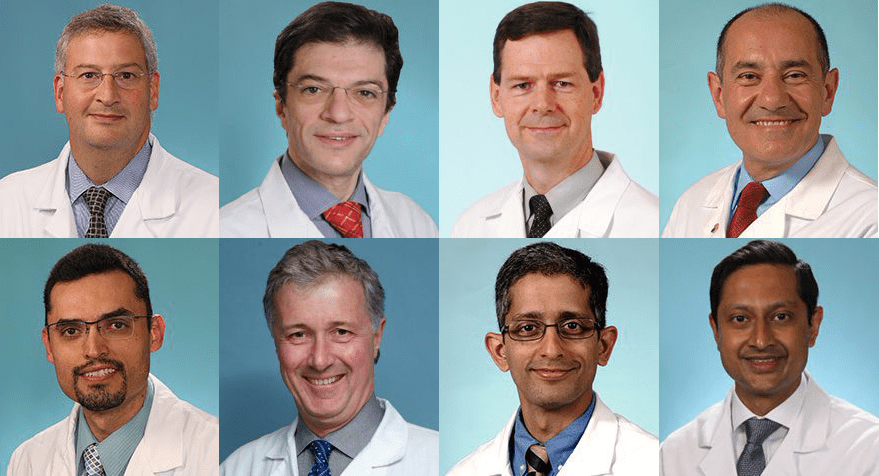With their rich history of innovation, utilization of leading edge techniques and multidisciplinary approaches to lung cancer treatment, Washington University thoracic surgeons provide the highest level of care for patients with lung cancer.
The thoracic surgeons, joined by a multidisciplinary team of medical oncologists and radiation oncologists, pulmonologist, psychologists, nurses and additional medical support staff, provide nationally recognized expertise in the diagnosis and treatment of lung cancer at Siteman Cancer Center. The team treats approximately 900 new lung cancer cases each year and is ranked 13th in the nation for cancer treatment by U.S. News and World Report. The pulmonology and lung surgery team is also ranked 25th in the nation and are experts in offering the latest diagnostic tests and cutting-edge treatments.
According to the National Cancer Institute at the National Institutes of Health, lung cancer is the third most common cancer and the leading cause of cancer death in both men and women in the United States.
There are several risk factors to lung cancer, but smoking cigarettes, pipes or cigars is widely regarded as one of the lung cancer’s major risk factors. This monumental discovery, made in 1950 by Evarts A. Graham, MD, founder of the Division of Cardiothoracic Surgery, and Ernst Wynder, MD, is regarded as one of the earliest publications to link cigarette smoking to lung cancer .
In addition to smoking, exposure to factors such as secondhand smoke, family history of lung cancer, exposure to asbestos, tar, chromium, nickel, arsenic, soot and radon have also been linked to lung cancer.
“Since many patients do not experience symptoms, lung cancer is often diagnosed in its late stages when it is most deadly,” says Bryan Meyers, MD, MPH, Chief of Thoracic Surgery. “When detected early, lung cancer is treatable and can even be cured with surgery.”
Anyone between ages 50-80 years with a smoking history of at least 20 “pack years” (smoking a pack of cigarettes a day for a year or an equivalent amount) who currently smokes or quit within the last 15 years are eligible for lung cancer screening under the recently updated guidelines.
“In the past, there was little we could do for our patients who were diagnosed with advanced-stage lung cancer,” says Benjamin Kozower, MD, MPH, Professor of Thoracic Surgery. “The new guidelines expand the eligibility for lung cancer screenings, which will help save lives and help detect cancer in its earliest stages that are potentially curable.”
The Lung Cancer Screening Program at Siteman Cancer Center involves more than just a quick scan of the lungs. Instead, the team established a patient-centered collaboration which places a major emphasis on smoking cessation, intensive report interpretation and cutting-edge imaging.
Upon a diagnosis, the lung cancer team will help determine the right path of treatment based on the patient’s type and stage of the cancer as well as the patient’s overall health.
“For each type of lung cancer, there are standard treatments— such as surgery, radiotherapy and chemotherapy— and clinical trials,” says Meyers. “Careful diagnosis is so important to determining the best treatment options for both non-small cell and small-cell cancer patients.”
The major treatments for lung cancer include surgery or radiation to treat local tumors and chemotherapy to treat the whole body. Chemotherapy is especially beneficial in treating cancer cells that have spread. Clinical trials are also underway that investigate promising new approaches and disease management opportunities.
Upon diagnosis and discussion with the patients, surgery may be considered to remove lung tissue based on the extent of the cancer. In all procedures, the lung cancer team utilizes techniques aimed at removing the lung tumor while sparing as much lung tissue as possible.
If the cancer is progressed to a point where an entire lung is compromised and unresponsive to other treatment, surgeons conduct a pneumonectomy, or full lung removal, but only when absolutely necessary.
Some lung cancer patients have the option to undergo minimally invasive robotic-assisted lobectomies which allows surgeons to work delicately inside the body.
“Robotic-assisted lobectomies are conducted through a number of small incisions rather than a single larger one,” says Varun Puri, MD, MSCI, Professor of Surgery, who utilizes these minimally invasive techniques in thoracic surgery. “This means our patients tend to leave the hospital earlier, recover faster and experience less pain than patients treated with traditional, open procedures.”
The thoracic surgeons on the Lung Cancer Treatment team perform an average of 150 lobectomies a year and use minimally invasive techniques, including robotic assistance, whenever possible.
In addition to their surgical practices, the highly collaborative team of surgeons also make significant advancements in clinical research. Their cases and research have been published in the medical field’s most prolific journals such as the Journal of Thoracic and Cardiovascular Surgery, the Annals of Thoracic Surgery and many others.

Washington University Lung Cancer Specialists:
- Benjamin Kozower, MD, MPH
- Daniel Kreisel, MD, PhD
- Bryan Meyers, MD, MPH
- Nabil Munfakh, MD
- Ruben Nava, MD
- Alexander Patterson, MD
- Varun Puri, MD, MSCI
- Shuddhadeb Ray, MD, MPHS
Washington University thoracic surgeons provide screening, care options and treatments for lung cancer across the wide network of hospitals throughout the St. Louis region and beyond.
To make an appointment with a Washington University thoracic surgeon, please call 314-362-7260.
